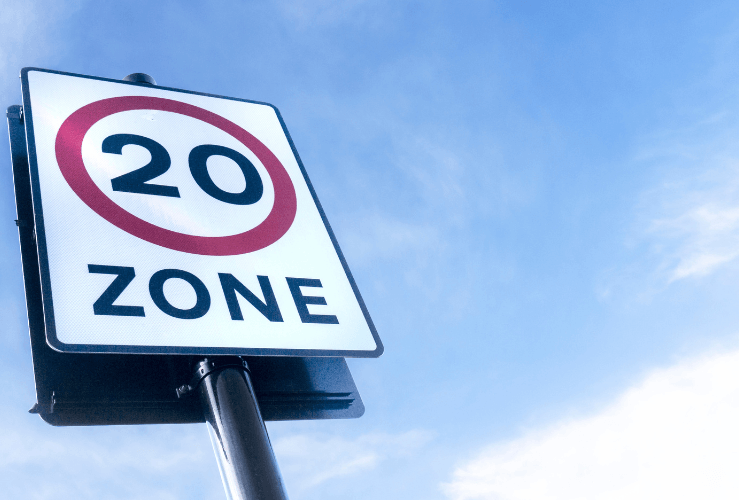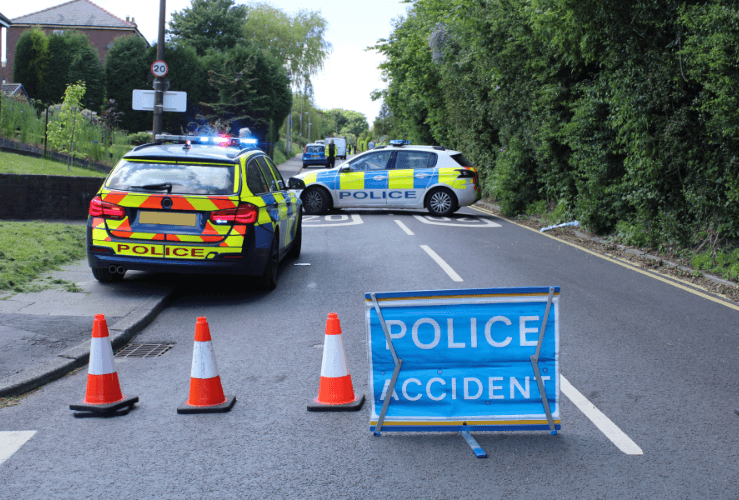The UK's approach to speed limits has once again entered public discourse, after Wales introduced a 20-mph speed limit in built-up areas on 17 September 2023.

The Welsh government (Llywodraeth Cymru) made the change in order to reduce collisions and associated injuries; to relieve pressure on the NHS; and to encourage more people to cycle or walk.
In England, Scotland and Northern Ireland, the speed limit in built-up areas remains at 30 mph.
The 30 mph urban speed limit is comparable to other European countries (e.g. France and Germany, where it is 31 mph).
However, mainland European carriageways, dual carriageways and motorways often have higher speed limits than the UK. For example, the German Autobahn has no limit on some stretches, and French motorways are limited at 80 mph, with dual carriageways limited at 70 mph - for most cars.

Credit: Sue Edmondson - stock.adobe.com
Do lower speed limits reduce accidents?
Not all Welsh motorists - nor the UK Prime Minister - are pleased with the recently introduced 20mph urban speed limit, while some drivers in other parts of the UK are anxious about it being extended.
However, studies suggest the 20-mph limit will reduce road traffic collisions and associated injuries and deaths.
The Royal Society for the Prevention of Accidents "strongly supports the use of 20 mph zones as they are an effective means of reducing road crashes and casualties.
"They are very effective at protecting our most vulnerable road users, including children, pedestrians and cyclists, and significantly decrease the risk of being injured in a collision."
Indeed, most pedestrian road deaths occur on roads in built-up areas.
RoSPA's factsheet states: "29 of the 34 child pedestrians and 302 of the 413 adult pedestrians who were killed in 2016, died on built-up roads."
More than half of cyclist deaths - and the majority of cyclist injuries - occur on urban roads.
One study quoted by RoSPA concluded that "at 20 mph there was a 2.5% chance of being fatally injured, compared to a 20% chance at 30 mph."

The argument for an 80-mph motorway speed limit
At the other end of the scale, there have been efforts to increase the UK's motorway speed limit from 70mph to 80 mph. Back in 2011, the then-Transport Secretary Philip Hammond proposed raising the limit to 80mph.
The DfT stated at the time that "as many as 49%" of drivers break the 70mph speed limit, and that "raising the limit to 80mph would mean that millions of otherwise law-abiding motorists would be brought back inside the boundary, restoring the moral legitimacy of the system."
It has been argued that a higher speed limit would bring economic benefits to the UK, and bring the nation in line with most other European countries.
How to tell the speed limit if there are no signs
It's not always obvious what the speed limit of a certain stretch of road is, due to a lack of speed limit signs in many built-up areas - and on some 'national speed limit' roads.
However, there are two rules that can help ensure you don’t break the local speed limit
Two easy rules if you can't see a speed limit
- If you see streetlights, stick to the ‘built-up area’ speed limit.
In England:
If you haven’t seen a speed limit sign but you can see streetlights, stick to 30 mph. Stay at 30 mph until you see a speed limit sign/road marking - sometimes referred to as a 'repeater'.
Many suburban roads do not have any signs displayed. Again, it's important to err on the side of caution and stay under 30.
In Scotland:
Again, in Scotland, the speed limit for urban areas is 30 mph.
In Northern Ireland:
The urban speed limit (where streetlights are present) is 30 mph in Northern Ireland, although in some areas of central Belfast the speed limit is 20 mph.
In Wales:
The same rule holds true in Wales, except the speed limit in areas with streetlights is now 20 mph (since 17 September 2023).
- If no streetlights are present, you can assume the national speed limit is in place.
For most cars, this is 60mph on a single carriageway, and 70 mph on a dual carriageway or motorway.
NB speed limits vary for certain vehicles, such as HGVs. See table below.
This applies to England, Scotland, Wales, and Northern Ireland.
Locally set speed limits
Some councils set special speed limits in particular areas. For example, they might reduce the urban 30 mph limit to 20 mph near a school; or reduce a single carriageway from 60 to 50 if it features sharp bends.
Future speed limit changes
Britain's effective management of traffic speed is a key reason why it has the fourth-lowest road traffic death rate in Europe, at 2.81 deaths per 100,000.
And while the new speed limit of 20 mph in Wales may irk some motorists, it's doubtless a move that should further reduce this figure.
At the other end of the spectrum, the campaign to increase the motorway speed limit to 80mph appears to have stalled.
But with automotive technologies such as self-driving cars on the horizon, time will tell how the UK's speed limit laws will change.
Current UK speed limits (as of November 2023)
UK built-up areas | |||
Built-up areas mph (km/h) in England, Scotland and Northern Ireland | Built-up areas mph(km/h) in Wales | ||
Cars, motorcycles, car-derived vans and dual-purpose vehicles | 30 (48) | 20 (32) | |
Cars, motorcycles, car-derived vans and dual-purpose vehicles when towing caravans or trailers | 30 (48) | 20 (32) | |
Motorhomes or motor caravans (not more than 3.05 tonnes maximum unladen weight) | 30 (48) | 20 (32) | |
Motorhomes or motor caravans (more than 3.05 tonnes maximum unladen weight) | 30 (48) | 20 (32) | |
Buses, coaches and minibuses (not more than 12 metres overall length) | 30 (48) | 20 (32) | |
Buses, coaches and minibuses (more than 12 metres overall length) | 30 (48) | 20 (32) | |
Goods vehicles (not more than 7.5 tonnes maximum laden weight) | 30 (48) | 20 (32) | |
Goods vehicles (more than 7.5 tonnes maximum laden weight) in England and Wales | 30 (48) | 20 (32 | |
Goods vehicles (more than 7.5 tonnes maximum laden weight) in Scotland | 30 (48) | 20 (32 | |
Single and dual carriageways and motorways | |||
Single carriageways mph (km/h) | Dual carriageways mph (km/h) | Motorways mph (km/h) | |
Cars, motorcycles, car-derived vans and dual-purpose vehicles | 60 (96) | 70 (112) | 70 (112) |
Cars, motorcycles, car-derived vans and dual-purpose vehicles when towing caravans or trailers | 50 (80) | 60 (96) | 60 (96) |
Motorhomes or motor caravans (not more than 3.05 tonnes maximum unladen weight) | 60 (96) | 70 (112) | 70 (112) |
Motorhomes or motor caravans (more than 3.05 tonnes maximum unladen weight) | 50 (80) | 60 (96) | 70 (112) |
Buses, coaches and minibuses (not more than 12 metres overall length) | 50 (80) | 60 (96) | 70 (112) |
Buses, coaches and minibuses (more than 12 metres overall length) | 50 (80) | 60 (96) | 60 (96) |
Goods vehicles (not more than 7.5 tonnes maximum laden weight) | 50 (80) | 60 (96) | 70 (112) 60 (96) if articulated or towing a trailer |
Goods vehicles (more than 7.5 tonnes maximum laden weight) in England and Wales | 50 (80) | 60 (96) | 60 (96) |
Goods vehicles (more than 7.5 tonnes maximum laden weight) in Scotland | 40 (64) | 50 (80) | 60 (96) |




